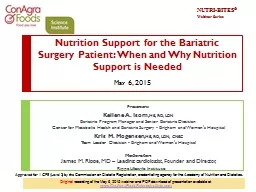

Kellene A Isom MS RD LDN Bariatric Program Manager and Senior Bariatric Dietitian Center for Metabolic Health and Bariatric Surgery Brigham and Womens Hospital Kris M Mogensen ID: 933437
Download Presentation The PPT/PDF document "May 6, 2015 Presenters:" is the property of its rightful owner. Permission is granted to download and print the materials on this web site for personal, non-commercial use only, and to display it on your personal computer provided you do not modify the materials and that you retain all copyright notices contained in the materials. By downloading content from our website, you accept the terms of this agreement.
Slide1
May 6, 2015
Presenters:Kellene A. Isom, MS, RD, LDNBariatric Program Manager and Senior Bariatric DietitianCenter for Metabolic Health and Bariatric Surgery - Brigham and Women's Hospital Kris M. Mogensen, MS, RD, LDN, CNSCTeam Leader Dietitian - Brigham and Women's Hospital Moderator:James M. Rippe, MD – Leading cardiologist, Founder and Director, Rippe Lifestyle Institute
Approved for 1 CPE (Level 2) by the
Commission on Dietetic Registration, credentialing agency for the Academy of Nutrition and Dietetics.
NUTRI-BITES®Webinar Series
Nutrition Support for the Bariatric Surgery Patient: When and Why Nutrition Support is Needed
Original
recording of the May 6, 2015 webinar and PDF download of presentation available at:
www.ConAgraFoodsScienceInstitute.com
Slide2Based on this webinar the participant should be able to:
Outline the four types of bariatric surgery and the mechanisms by which they affect nutritional status. List indications for initiation of nutrition support therapy in the bariatric patient and determine appropriate mode of nutrition support therapy (enteral vs. parenteral nutrition). Illustrate nutrition care considerations necessary when working with bariatric patients on nutrition support therapy. Apply nutrition support therapy across the spectrum of care for bariatric surgery patients and identify resources available to RDNs working with bariatric patients on nutrition support therapy.NUTRI-BITES®Webinar Series
Nutrition Support for the Bariatric Surgery Patient
Slide3What is Weight Loss Surgery?A group of ‘bariatric and metabolic’
surgical operations that impact the physiological regulation of body weight and improve morbidity and mortality rates.
Slide4Gastric/RestrictiveRestricts total amount of food that can be eaten at one time; no alteration of food pathway
Laparoscopic gastric banding CombinationGastric manipulationNeural/hormonal changesRoux-en-Y gastric bypass (RYGB)Sleeve gastrectomy (SG)MalabsorptiveMalabsorbtion of calories and micronutrientsBiliopancreatic Diversion (BPD) w/ or w/o Duodenal Switch (BPD/DS)Types of Bariatric/Metabolic Procedures
Slide5Altered Absorption of Micronutrients
Vitamin/Mineral Lab MonitoringBPD/DS
RYGB
SGLAGB
CalciumBone Density*
Iron
Fe panel, Ferritin, TIBC
Vitamin B12
Vitamin B
12, MMA FolateRBC Folate ThiaminSerum Thiamin Vitamin D**25-OH-Vitamin D&Serum PTH ZincSerum or Plasma Zinc CopperSerum Copper and Ceruloplasmin Vitamin A, E, and KPlasma Retinol, Plasma Alpha Tocopherol, and Prothrombin Time (PT)
*In peri- or post-menopausal women **Often low in obese patients and should be assessed and repleted prior to surgery
Aarts
et al. Obes Surg. 2011;
Aills
, et al. SOARD, 2008;
Gehrer
, et al. Obes Surg. 2010;
Mechanik
, et al. SOARD. 2013;
Moize
, et al. JAND, 2013.
Slide6Consider nutritional support if any of the following conditions are present:
Patient has been without nutrition for 5-7 days Expected duration of illness > 10 days Patient is malnourishedIs GI output > 600 mL/24 hr, massive GI hemorrhage, prolonged ileus or other contraindication to enteral feeding?Initiate Enteral Nutrition
Enteral feeding not tolerated
Administer Parenteral NutritionInitiate nutritional support only if tissue perfusion is adequate and electrolytes and acid-base balance are near normalEnteral Feeding Tolerated
Reassess PN Need
NO
YES
Brigham & Women’s Hospital
Algorithm for Determining Route of Nutrition Support
Transition to oral diet if/when able
Slide7Enteral Tube Placement
From Krause’s Food and Nutrition Therapy, 12th edition.
Slide8Enteral Formulas
Formula TypeCharacteristicsStandard PolymericIntact protein, carbohydrate, fat
Some formulas have fiberGenerally for patients who have no problems with digestion or absorption
Semi-elementalProtein as peptides, carbohydrate and fat may be somewhat broken down
ElementalMacronutrients are essentially all “predigested”
Disease specific
Designed
for specific organ dysfunction
Slide9MonitoringGI symptoms:Abdominal pain/distention
Nausea, vomitingConstipation, crampsDiarrheaEsophageal refluxPulmonary complicationsRespiratory distressAspirationHydration statusUrine outputWeight changeInput/output recordsLabsLaboratory signs of dehydrationElectrolyte imbalances Hyper/hypoglycemiaEnteral access problemsClogInfectionResponse to nutritional therapyLab indicatorsStrength, functional statusWound healingCorrection of nutrient deficiencies
Slide10Venous Sites from Which the Superior Vena Cava May Be Accessed
Ideal catheter tip location for PNFrom Krause’s Food and Nutrition Therapy, 12th edition
Slide11PN Monitoring & ComplicationsMetabolicElectrolyte imbalanceHyper/hypoglycemiaDehydration/
overhydrationMetabolic bone diseaseGastrointestinalCholestasisFatty liverGI atrophyInfectiousLine sepsisMechanicalAssociated with the venous catheter itselfResponse to nutritional therapyLab indicatorsStrength, functional statusWound healingCorrection of nutrient deficienciesRisk of nutrient excess
Slide12Practical ApplicationsScreen patients for nutritional riskConsider nutrition support if unable to take an oral dietAlways consider EN first if the patient has a functional GI tract and able to insert a feeding tubeConsider PN if the patient has intestinal dysfunction or absolute contraindication to insertion of feeding tube
Consult the bariatric surgery with any questions about GI anatomyBe aware of risks of micronutrient deficienciesWork with the bariatric dietitian for transition from nutrition support to an oral diet
Slide13The 2nd Edition of the Academy of Nutrition and Dietetics Pocket Guide to Bariatric Surgery
What’s New?Nutrition care for Sleeve Gastrectomy procedurePre-operative weight loss and pre-operative nutrition assessmentPre- and post-op care of bariatric patients on renal dialysisPost-op care of patients with type 1 diabetes Weight regain prevention and treatment after bariatric surgerySample outlines of a standardized pre- and post-op Nutrition Care Program